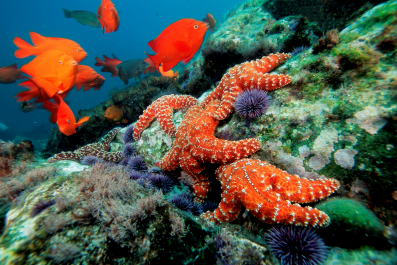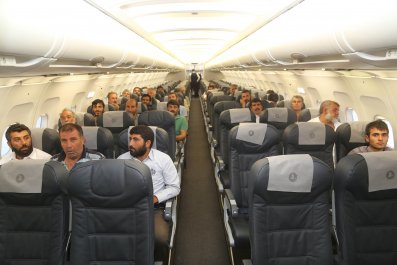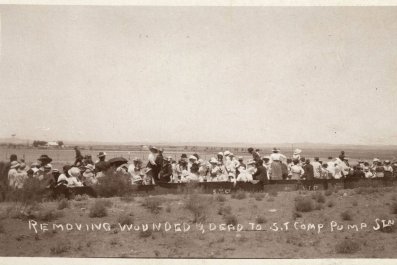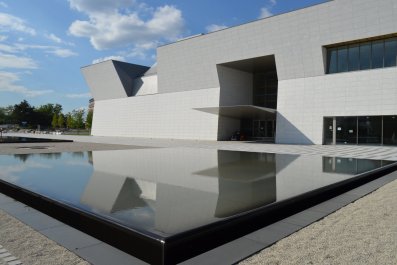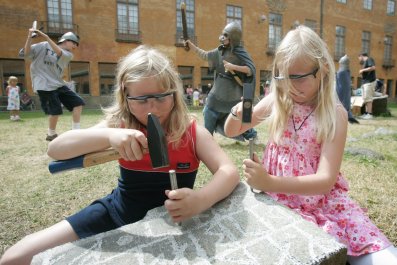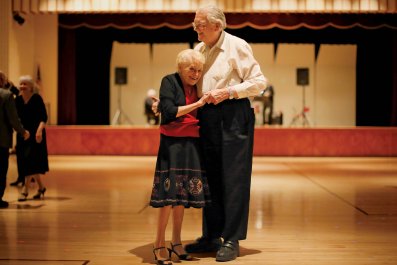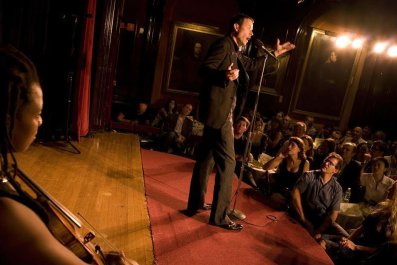So, it's Thursday afternoon in Monaco on the first day of the 12th annual Anti-Ageing Medicine World Congress, and "Facial Reshaping: the American Way" is just getting going. It's that snoozy time after lunch, 3pm, but there's a palpable sense of anticipation in Room Nijinski, deep in the Grimaldi Forum convention centre. The audiovisual kit's prepped, a crowd of attendees is thickening. There's a booth up ahead and to the left, walled with curtains.
In there, on a hidden couch, the "American Way" of reshaping is going to go down, rebroadcast on a big screen. When the reshaping gets under way – and it's going to start in a few minutes now – the Room Nijinski audience will see a nicely lit shot of the first victim-patient (whom subsequent shoe leather inquiries will reveal is a 35-year-old woman called Camille, who really doesn't want her last name published but seems to make quite a nice living being professionally good-looking at various commercial junkets along the Côte d'Azur).
As the needles go in, push-pull, forward and back, we'll see only Camille's face, with her hair tight back under a pharma company headband. We won't see her hands, which subsequent poking around will suggest, have in fact been furiously squeezing on a stress ball, also provided by Laboratoires Teoxane, the Swiss sponsors of the event. Even here, in Monte Carlo, at the hands of the very top practitioners in the world, this thing of dermal fillers is not wholly painless.
There's a further illusion here too, because although the event is ostensibly about process (viz. "The American way"), it is really about the practitioners, the needle-wielders themselves. It's not a contest, officially. We're still 40-odd hours away from the "Hemiface Battle", in which two doctors will split a woman's face lengthwise and work in parallel in an obviously adversarial construct. This afternoon's session is theoretically collaborative.
Let's meet the stars. First, Dr Raj Kanodia. Standing in his converse sneakers just before showtime, he is wearing an open-necked shirt and bangles. Hollywood surgeon and Calcutta-boy-made-very-good Kanodia charges about $15,000, three times the market rate, for a rhinoplasty. He considers himself an artist and reportedly straightened Ashlee Simpson's snout.
His partner is Fredric Brandt, Miami's king of collagen. Today Brandt is wearing a ribbed Givenchy shirt with zips, a funky bangle, a gold watch and Balmain trousers – later in the congress I will see him in what appear to be culottes and toting a huge Louis Vuitton bag with green lettering. However, Brandt's outré clothes are not the most striking part of his appearance. His face wins.
Brandt does not resemble a man in his mid-sixties, but neither does he look fully human. His skin is tight and freakish smooth, like an android's. At lunch, earlier, some German doctors said part of the appeal of this conference is seeing the monsters. Now I understand why.
They're off, Kanodia first and Brandt to follow, on another girl. The victim-patients squeeze their stress balls and the dermal filler needles are going in plunge-plunge. There's a seemingly Teutonic emcee that says "25-gorge" when he means "gauge" with regard to needle diameter. Later, the first victim-patient will stand outside the curtained booth with her face full of fresh Teoxane filler and an expression like she's just given a blowjob for cash.
Kanodia is mid-spiel, and I'm thinking about how he said earlier he's in town for six days though the congress is only three because "I'm going to have a little fun." I think there's maybe self awareness here, that he understands it's all a game and that – as a girl from Bangalore suggested to me in a pub in West London – he's living the Indian dream and fair play to him.
This place, in case you haven't gathered, is the hinterland of the weird. It's Monaco in April, with the sun on the Mediterranean, yachts the size of early modern naval vessels in the harbour and the prep work for the Grand Prix already under way. The picture of the Prince and his South African wife hang in the public places where I know from past experience in Africa that the likeness of the local despot always goes. It's the world's top cosmetic surgeons gathered with an itinerant cast of self-styled well being gurus, PR fraus and pharma reps. Almost 9,000 attendees in total, according to the organisers. They're all down here in Monaco.
Let's talk, briefly, about scale. Surgical cosmetic procedures like breast augmentation and liposuction were worth $6bn globally in 2012, according to IMCAS, a French industry forum. In Tehran, girls who haven't had surgery wear plasters on their noses to suggest they've been cut. In South Korea 'V-line' work aims to give women the elfin face shape popularised by anime. Botox is like edamame now, an urban lunchtime staple. And here, in the feudal blip that Somerset Maugham once called a "sunny place for shady people", the annual general meeting of this brave new world is just kicking off.
On the first morning I march down the Fairmont hairpin, traversed currently by buses and misbegotten Ferraris but, in due course, a key bend in the F1 course. Here's the Grimaldi Forum on the shore. In the accreditation tent I speak to an American doctor currently working in Moscow. Her face is so immobile that visual clues of emotion are quite absent. It's like conversing with a waxwork. That isn't going to be the last time that happens here.
Let's be clear on something, while we're still out milling among the flunkies and the apparatchiks, waiting for it all to begin. There are girls here at the AMWC '14 who look like deep-sea creatures or the punchlines to bad jokes, their lips and cheeks swollen and grotesquely turgid. And of course there's Dr Fredric Brandt. But that's not the whole story. Here too, wandering the exposition halls and also in wider Monaco, are women so beautiful, that if parachuted into a metropolitan area in North America or Northern Europe, they would cause major disruption to construction and window cleaning activity across a six-block radius.
I've got the AMWC programme now. I've worked out the sessions I wish to attend. Now they're throwing open the doors, after lunch on Thursday. The place is configured like an Escher drawing. Halls jut into multilevel lobbies and hired goons with barcode readers man the intersecting escalators. Temporary partitions divide the stalls for the individual exhibitors that cram the main halls. At the Teoxane corral a diaphanous plastic cylinder holds a blend of stress balls and syringes. Over at Allergan I watch a short haired woman roll her shoulders dramatically while making some pseudo-scientific point about "long molecules". Close by, Vivacy is promoting "Desirial", defined on vitreous backlit hoardings in the following manner:
"The 1st injectable cross-linked hyaluronic acid based medical device specifically designed to improve:
the vulvovaginal trophism in adult women (DESIRIAL ®).
The aesthetic appearance and function of the vulva region (DESIRIAL PLUS ®)."
It comes boxed-up in cardboard like Turkish delight, yellow for Desirial and orange for Desirial Plus. Elsewhere I see rubbery models of faces with needles stuck in and once, alarmingly, a pinioned ersatz vagina in the same material.
And, everywhere, the machinery of trimming and reshaping, liposuction and liposculpture – these devices all look curiously similar, perched on their rubber wheels with kick-brakes like wheelchairs. They have computer screens attached but there is something that seems oddly primitive about them, as if they're really bound for sanatoria high in the Alps, in the days before streptomycin put an end to consumption and another profitable Euro-medical junket.
There's a war of words too. Everywhere I find the lexis of the medical industry, fictionalised terms with a timbre of trust: lutronic, bioptron, kryokontor, revitacare, noblex. But there's one exception. Botulinum toxin. It's out, loud and proud, in the public sphere on hoardings and flyers. I even see a video referring to a "commitment to botulinum toxin". The anti-ageing industry has clearly thought hard how to deal – from a marketing standpoint – with the fact that its trump wrinkle management product is one of the world's most potent toxins. The apparent solution is to hide in plain sight. To redeem the toxic word and take the nigger-queer repurpose path to verbal acceptance.

The first session I attend is called "IT COULD HAPPEN TO YOU! How to face the complications". I see my first slide of a skinned face, the flensed muscle all yellow and red. An English-as-a-second-language speaker turns to nautical metaphors. "Remember in your office after the congress you are alone at the helm of your boat," he remarks. "You have to reach harbour. Be careful with the new techniques you are learning here."
I sneak out to "Facial Reshaping: the American Way". When that pantomime is done I descend to level minus two for several hours of cosmetic gynaecology. During this gruelling stint in Auditorium Camille Blanc, polyglot speakers will pronounce those five syllables in every conceivable manner. I will hear variously about "gyne-logical care," "jean-a-cology," and "gin-col-ogical disease" I will see stylised runic depictions of female genitalia serving as badges for professional associations. Euphemistic PowerPoint will strive for good taste but sometimes be more alarming than the alternative high-res, legs akimbo shots. A slide of soft fruit and a scalpel is particularly memorable.
We'll come in due course to the proliferation of cosmetic gynaecological procedures and the attendant controversy. Now though, deep in Auditorium Camille Blanc, what's really at stake is the absence of Dr Michael Goodman. He's first on the programme ("The biomechanics and physiology of orgasm and vaginal tightening operations: Why they work"). But he's not here. The emcees make repeated allusions to Goodman's shifting whereabouts: his plane is delayed. He's at the airport. He's coming now.
At the end, when Goodman's finally arrived and spoken, we all mill about down on the stage. A clutch of AMWC '14 attendees basically mob the doctor. It's suddenly clear that if you're out in the hinterlands of cosmetic gynaecology, scratching an honest living via labiaplasties and the odd vaginal bleach in the UAE or Peru then, to you, Dr Michael Goodman of Davis, California . . . well, basically he's some kind of minor godhead.
Quick cosmetic gynaecology primer, courtesy of consultingroom.com:
1) With Labiaplasty the inner vaginal lips can be reduced in size and reshaped.
2) With Vaginoplasty the inner vagina walls and muscles can be reshaped and tightened to produce a more toned and tight vagina.
3) And with Hymenoplasty a torn hymen can be repaired or rebuilt to imply the virginal state of a woman.
Bleaching, I think, is basically pretty self-explanatory.
It's on the up, this stuff. Parties for and against proffer the same reasons; pornography and hair removal and women's consequent wider comparative knowledge of other women's genitals. That's why it's on the up, this stuff down there.
Next morning now, Friday, and I'm in the Grimaldi Forum VIP suite with four of the key cosmetic gynaecological players. There's Briant Herzog MD, out of Plano, Texas, soft spoken and white-haired and very southern. There's Gustavo Leibaschoff, moustachioed and Argentine. Pablo González up from Columbia. In the jungle pecking order here, Leibaschoff and Herzog, who emceed the event yesterday, seemingly rank below Goodman, who's still in the suit he flew in. Goodman's sitting with his legs wide apart and his hand down in his crotch. It's bleakly obvious that in this particular world, Michael P Goodman MD is the senior silverback.
They're really nervous these men. Anxiety is literally coursing off them. Goodman starts, saying he's had bad past experiences with reporters. He speaks as though referring to an unfortunate but non-negotiable feature of the exterior world, like the existence of wasps. Not anything even tangentially connected to the fact he performs cosmetic procedures on vaginas.
We'll hear them out, these four, in a moment, but let's look first at the business cards now passing across the table. They're quite something. Herzog, has two. One's for the Hormone Therapy Centers of America, where he is "vice president of medical affairs", with swirling green and blue patterns. His other card has a red embossed box holding a gothic white "H". Leibaschoff's got two cards too, one bearing a stylised woman's torso representing the "International Academy of Cosmetic Gynecology".
Goodman's reads "Caring for Women Wellness Center", which is syntactically off key. There's an illustrative woodcut of a woman toting a watering can. I wonder if that's some good-taste allusion to incontinence but I can't be sure because it's only Dr Pablo González whose card reads "Incontinencia Urinaria Femenina", among other services rendered.
Pablo's the junior man here, by the way, d'Artagnan to the gynaecological musketeers if we're taking the Dumas analogy. In business card terms, though, the apprentice beats all the silverbacks. His card has two corners bevelled and the others sharp. On both sides there's a silhouette of a woman leaping, black on a white field on one side and white on pink on the other.

The dictaphone's rolling, and the gynaecologists are by turns defensive and ebullient. Goodman's big on the function – not just aesthetics stuff – (which others dispute). At one stage he comes down hard on "probably-a-woman" ObGyns who tell concerned patients their labias are just fine. "Puritanical" is the other term Goodman uses here. But it's young Pablo who's the best sport. When I ask who else I should talk to, it's Pablo who gamely suggests Dr Linda Cardozo in England, because she's apparently opposed to this whole thing they do.
It's three weeks before I track down Dr Cardozo. The professor of urogynaecology at London's King's College Hospital is super busy, with no time to meet in person, but she'll do a phone call. She's brusque at first but warms up pretty soon. You come away thinking Dr Cardozo's kind of like your first girlfriend's mother – initially terrifying but ultimately excellent value. She steers a careful line viz. cosmetic work.
"I try very, very hard to keep a very balanced view on this. I don't want to deprive women of things that make them feel better, but I don't want the private practitioners to make money out of women's body insecurities."
Rewind. Back to Monaco, still on Friday but earlier. I'm at the Métropole mall, inland from the Grimaldi forum. I'm meeting Margie Lombard at her eponymous salon.
A woman I know in London, a former Monaco resident who self-identifies as a trophy wife, has sent me Lombard's way with the explanation that she runs Monaco's premier beauty establishment. Margie herself comes from Alsace. She's wildly pleased by my ability to speak French, though we switch to English for the real stuff. I know there's going to be a lot of specialised vocabulary about serums and moisturisers and, frankly, I don't want to miss a single word.
Lombard reckons the beauty regime for a serious Monégasque woman costs around €6,000 per year. Her bestselling product is a "Triple Concentrate Prestige Serum" – €498 for a 30ml tube. Her most expensive offering is a gold facemask package only available in her Dubai branch for €5,800. A brochure shows something like the chainmail headgear once worn by crusading Knights Templar. It's probably best here if I merely report our subsequent conversation verbatim, from the tape.
Akam: "So that's like to gear you up to go to bed with a really old man afterwards?"
Lombard (laughing): "Voilà, exactement. You got it."
Back to the Grimaldi. At the big lunchtime press conference lady journos ask beauty-related questions with tones so serious they might be probing the next move in the Ukraine. I befriend Cinzia Sgambati-Colman, a polished older woman who edits a magazine for Monaco's Italophone community. Over lunch tomorrow she'll explain that the reason you see no children in Monaco is that they're all studying or playing sport. At one stage too, Thierry Besins, a plastic surgeon from Nice who is one of the congress' medical directors, holds up both his hands to salute the journo crowd like a post-goal footballer. Just like Raj and Fredric, Thierry, who incidentally resembles a distinguished permatanned stegosaur, wants to be a rock star too.
We're back with Raj now, for the hotly anticipated Newsweek-Kanodia bilateral. We're in a little booth in the Teoxane stand, and here too is Valérie Taupin, manageress of the company, whom Raj has dragged in to get some precious media airtime as well. It's now, or actually slightly later, when Raj has gone, and it's just Valérie and I alone, that the "perhaps 3,000" discrepancy about what Raj got paid to be here arises – i.e. Raj said he gets nothing but Valérie says he gets "perhaps 3,000". Dollars. For a workshop.
Raj also says the following: "With my fantasy and desire to be the best in pursuit of beauty, and that's to recognise and to enhance and identify with beauty – and Hollywood, being the Mecca of entertainment and beauty – I thought that would be the best place." Later he compares his work to art.
"It's all about art. My analysis is, what's the difference between a $2 painting and a $20m painting? It's where you place the filler, how you design the nose, how you refine the nose."
Raj likes paintings by Rubens. No girls in Monaco, though, resemble paintings by Rubens. Later, he brings in Garth Fisher, the first doctor selected for the ABC programme "Extreme Makeover". Raj partners up with Garth sometimes. Garth sees an art analogy too. Writing this, weeks later, I wonder how Dr Fisher's mother feels about her son's career.
It just doesn't stop though, this AMWC '14 shebang. Post-Raj I dive into a session on "home-use devices" before traipsing back pan-Grimaldi to see "Bionic Man". The initial attraction of this new session down in Room Auric is that the host, an affable Bavarian doctor, really is called Bernd Kleine-Gunk. Other interests surface though. Here's Rich Walker, managing director of the British Shadow Robot Company, discussing a literal bionic man he built for a television series. Walker's a little awkward. He's wearing a lot of black and his jokes fall slightly flat, and already I like him much more than the botox boys upstairs.
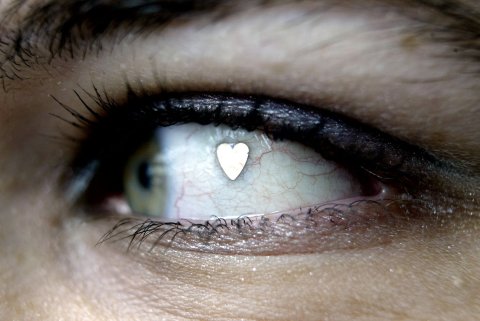
Another presentation examines electronic sensors inserted into the eyes of patients with degenerative macular conditions. Up spins a video – a tale of a Dutch woman blind for decades going to get her eye-robot fitted. I tell myself its propagandist junk. But when they turn the contraption on and she perceives light, if only a little, after years of absolute darkness, there's massive emotion on her face, which can't, surely, all be fake. After the absurdity of upstairs here is a clear example of the parallel promise of technology to ameliorate human suffering. I feel like I want to cry.
Now, ladies and gentleman, the moment you've all been waiting for, the Hemiface Battle. Aka La Bataille Des Hemifaces. It's the last morning now; we're down in the cavernous Salle des Princes, which surely is below actual exterior Mediterranean sea-level. The programme bills an "exciting live session performed by two experts: each expert injects one hemiface of a patient. They compare their techniques and the choice of products".
The victim-patients aren't in a curtained booth off-stage this time. Rather they're down the coast in Nice, at the Institut Universitaire de la Face et due Cou, connected here by a decidedly ropey video link. Thierry Besins, the permatanned stegosaur, has surfaced again as emcee. The initial performing surgeons are Nimrod Friedman of Israel and Philippe Kestemont, who's French. They crack on with their syringes.
The battle element is artificial – even to a layman it seems there's generally one accepted way to do this dermal filler thing, and they're only trading a cannula for a needle here and there for a bit of variety. It takes ages too. It's only when they're down from the forehead to maybe mouth level that I snap from my catatonia and realise the patient-victim is actually looking a whole lot younger than 90 minutes ago. And I think, ghastly though it is, this stuff actually works. Dorian Gray's alive before my eyes.
After lunch I walk to the harbour, following the pert behinds of the moored yachts. They're man'o'war huge, with unsmiling crews and names like Tiberon, Moneikos and Spyk. They're exclusively motor-driven and kind of hideous, but almost at the end of the maritime picket line, I find a great exception.
She's slim and sail-powered, her blocks and hardwood decking fully buffed. I look at this vessel, dwarfed by the dreadnoughts to port and starboard. She's without doubt the best-looking boat in the whole harbour. I can't tell if she's new and built to look old, or ancient but immaculately restored. There's some elaborate visual metaphor here about the weirdness of the Hemiface Battle, but I can't quite grasp what it means with regard to that Dorian Gray enactment until I look down and see on the stern plate of this beauty ship her name: Doriana.
'Search Engine Optimisation and Social Media Marketing' is my final AMWC '14 session. It's really the Alain Tenenbaum show. Tenenbaum's a Swiss plastic surgeon; short, bespectacled and violently quiffed. His left trainer reads Frankie and the right Morello. Again, what's about to follow is best reported in straight factual terms, with all value judgements left to the reader. You see, Alain Tenenbaum's got more than enough rope to hang himself now.
Throughout his presentation, in line with his ropey English, he says "notoriety" when he really means good reputation, with unintentionally hilarious results. He gleefully recounts ways to circumvent European bans on medical advertising by using US suffixes for websites and creating what appear to be impartial online lists of medical practitioners, but in reality exist to promote surgeons' own work. He talks even more gleefully about manipulating Google's search algorithm to make a negative online patient review go away. He advises the audience to deliberately include misspellings of cosmetic procedures in their website key words, so that "troglodytes" (his term) who can't spell chemopeel will still find him. Or them. Troglodytes, Dr Tenenbaum insists, make excellent patients.
Fast-forward three weeks. We're back in London now.
Williams Hogarth's Marriage A-la-Mode hangs in Room 35 at the National Gallery. The four panels depict the disastrous hitching of the daughter of a rich but mean city merchant to the dilettante son of the Earl of Squander. The saga encompasses venereal disease, debt, violence and, confusingly, a suspended narwhal's tusk. It's 21st-century Monaco in mid-18th-century oil on canvas, so it's here that I choose to meet Catherine Hakim.
She's wearing a pink leather jacket. A sociologist, Hakim sprung to prominence three years ago with the publication of Honey Money, a book laying out her theory of erotic capital. Hakim believes that a mix of physical attractiveness, charm and social skills determines much success in life. Rather than demeaning these attributes, Hakim believes we should openly acknowledge their importance. When she published, Hakim received much praise but also significant brickbats, in particular from the strident feminist women of the internet. In person it's clear she's a controversialist, someone who periodically, consciously or otherwise, has to engage in public bunfights.
I tell her about Monaco. Hakim suggests that, in the future, cosmetic procedures will become completely ubiquitous. That's not the real bombshell though. She adds that while men invest in their erotic capital less than women, the evidence suggests it's men who, in financial terms, see a greater return on it. I think of my impression of the sale of female beauty in Monaco and Dr Fredric Brandt's own enhanced countenance. I wonder if there's something here I haven't got.
Three days later, I visit Queen Victoria Hospital at East Grinstead in West Sussex. Here, during the war, a New Zealand surgeon called Archibald McIndoe pioneered plastic surgery, reconstructing the faces of burned aircrew. With savage insouciance these scorched young men christened themselves the "Guinea Pig Club". QVH today is a leading site for reconstructive surgery, but there's still a palpable sense of the 1940s to the place, with its low red brick buildings and the "Spitfire" restaurant.
I meet Martin Jones, a consultant reconstructive surgeon. He's in a suit initially, and a little nervous, but soon opens up. He takes me through a portfolio of his past work, featuring a girl who had her leg crushed by a London bus and a Polish man whose Staffordshire Bull Terrier bit off the end of his nose.
We're going to see Jones at work in a minute, evening-out the breasts of a woman left lopsided after cancer treatment. Beforehand though we require some authorial openness. When I first considered this subject, I knew that cosmetics in Monaco would be bizarre, even distasteful. I conceived reconstructive plastic surgery as a wholly separate territory, populated by heroic operatives stitching up after disease or mischance. Examining both sides might, I felt, offer a powerful heroes and villains narrative.
At East Grinstead it's clear though that binary separation doesn't fly. So, in a spirit of journalistic openness, I'm going to just try and let reality speak for itself. You see, there's always been a crossover.
Archibald McIndoe died in 1960. I find, though, a living eyewitness in the form of Bob Marchant, who worked at QVH, from 1956 until retirement, as chief technician in 1997. Marchant recalls McIndoe as a man beloved by his patients, a man who didn't suffer fools gladly. He tells me that in the 1950s McIndoe was also up in London much of the time doing cosmetic work.
We're back with Martin Jones. When I tell him about Monaco he's not fully comfortable. He says he doesn't approve of kissing a patient pre-op (an action that kicked off the Hemiface battle), or much of the other razzle-dazzle. Yet, he freely admits, he spends a day a week doing cosmetics in private practice. That day doubles his NHS salary. We're scrubbed up just outside the theatre. The patient's lying on a gurney. She seems in her sixties, deeply tanned and post-cancerous. The girls who are knocking her out ask about her recent holiday in Egypt. A gruff but likeable technician explains that the milky sludge in the syringe is Diprivan aka Propofol, the amnestic agent that killed Michael Jackson.
She's under now – the patient – her eyes taped shut, and they are wheeling her into theatre. Martin Jones is with his crew. One girl has a bandana with owls on. Dr Jones is wearing croc-like shoes with skull and crossbones pen-drawn on the toecaps. He explains they were the only ones he could find in the locker room. Dolly Parton, Morcheeba and Massive Attack feature on the operating theatre playlist. They're covering up bits of the patient and exposing others, until she's ready for the knife.
It's powerful, seeing something really complicated done calmly by people who've done it many times before. Jones is going into the abdomen with a needle to draw out fat with which to rebuild the right breast. There's the back and forth, tactile movement I saw with the fillers in Monaco. Now he's on the other side, handling a needle with a cutting edge. He's going at the right breast where the tumour was.
The scar pings away from the flesh beneath like elastic. They've got six syringe-worths of fat out now. They're going to whisk them up before putting them back in further north. It's amazing and not really gory at all. I'm glad to have watched this. It's refreshing after – but still not wholly distinct from – that other shebang down in Monte Carlo.







